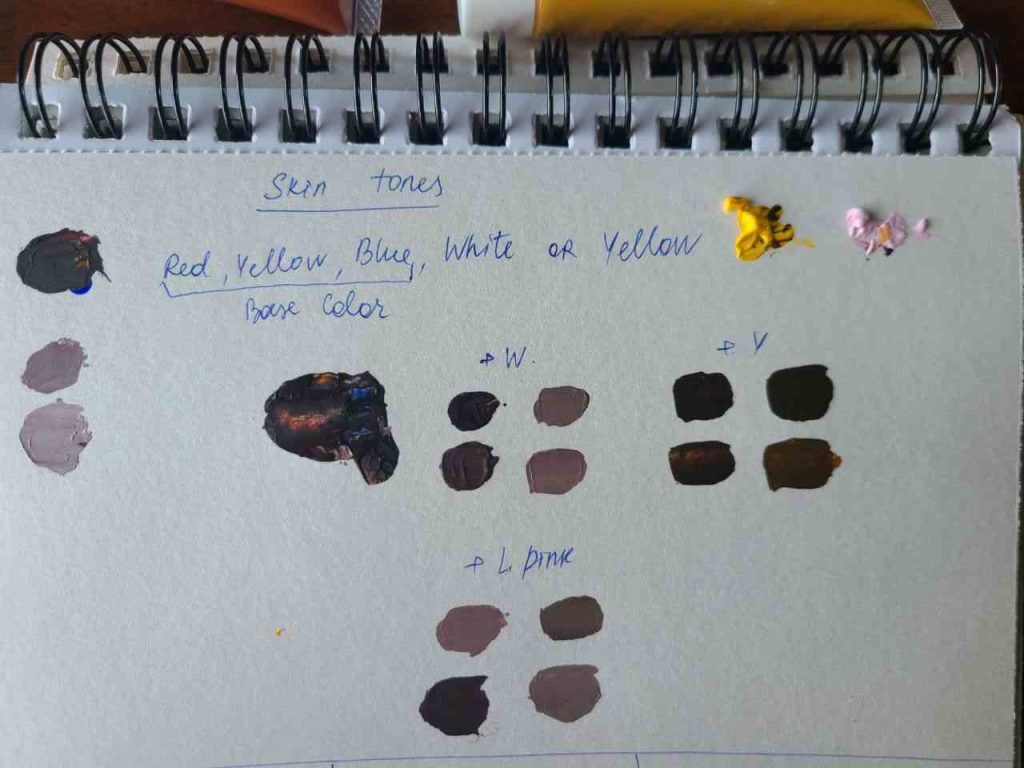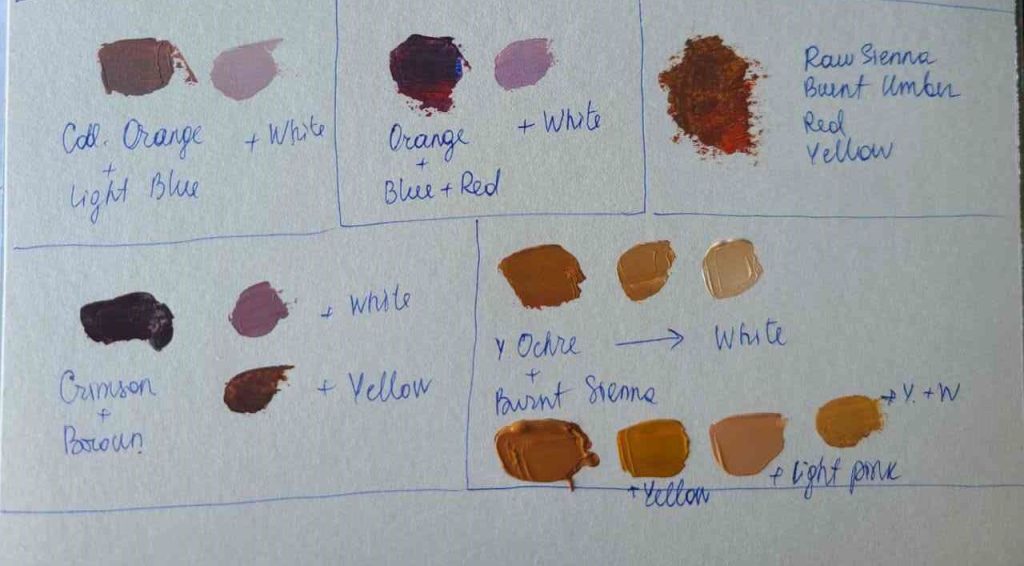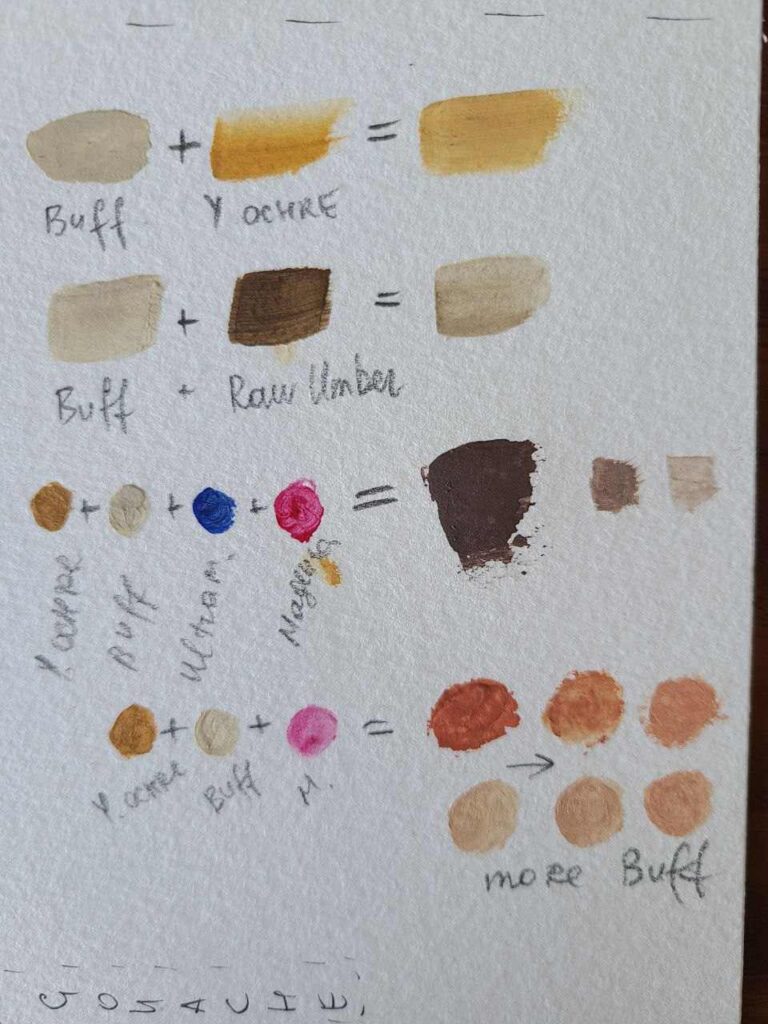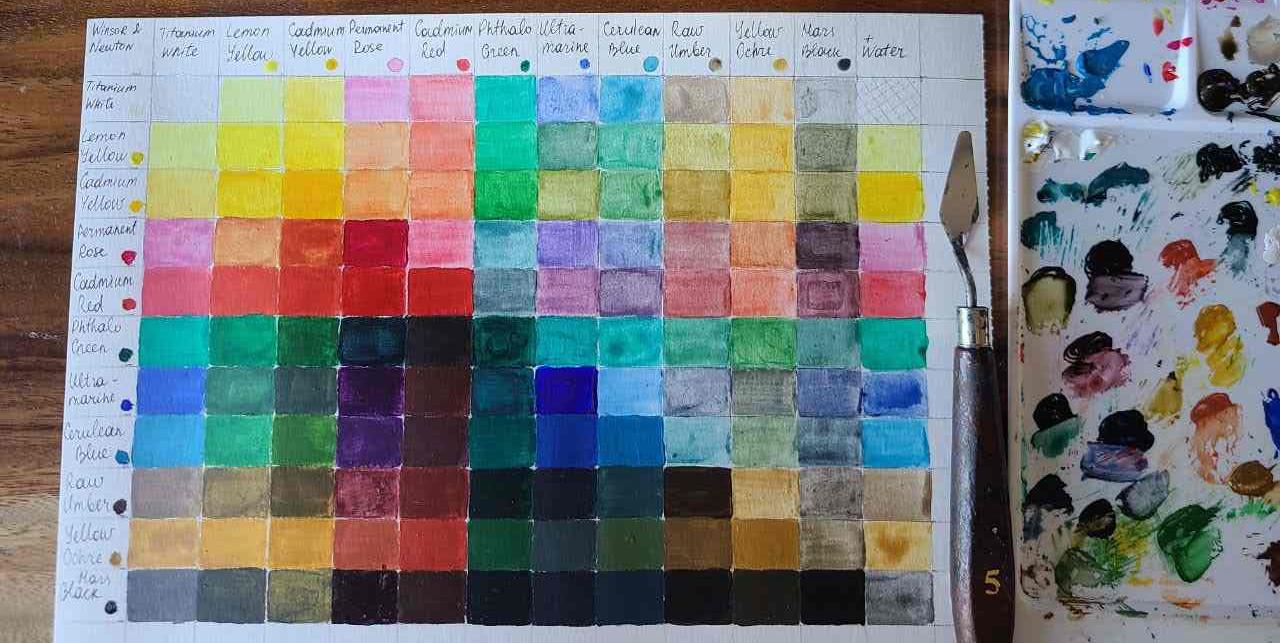Last Updated on March 21, 2024 by Masha Eretnova
Neutrals, natural colors, and skin tones are probably the most challenging colors to mix right. I know many beginners, myself included struggling and worrying about how to make skin color with acrylic paint and make it look realistic.
You can make skin tone colors with acrylic paints by mixng the primary colors red, blue, and yellow to create base skin color – brown and then use a little white, light pink or yellow acrylic paint to gradually lighten the skin color shade.
For this article, we will explore things we didn’t know we should learn when making skin tone colors, so sit back and be with us until we can make our own.
Table of Contents
What paint do I mix to make skin color?
With our resources these days, you can use different kinds of paints to mash up colors, like acrylic paint, oil paints, watercolors, and the like.
For starters, you may use the red, yellow, and blue paints you have in hand. Mix it with white until you achieve your desired shade.
Another trick is mixing raw sienna and manganese violet to create a beautiful brown shade and combining it with a portion of cremnitz white to make a skin tone.

Mixing primary colors you will create a base color for all skin tones – brown.
Adding white, yellow or light pink will help you create a needed shade of skin color and desired undertones.
If you added more blue, you can also have more purple-ish color that you can use for lips or shading on skin.
What colors make tan skin tone?
Aside from the primary colors red, blue, and yellow, you can also use orange, white, and light blue to make a tan skin tone color.
But my favorite and easiest way to mix colors that make tan skin tone is to use Yellow Ochre with Burnt Sienna and adjust the shade by adding white or yellow. You can even use light pink. See how I’ve experimented with tan skin tones:

How do you mix realistic skin tones with acrylic?
Skin tone color is one of the challenging colors to achieve, but nothing is impossible with you being creative! So, let’s start exploring possibilities. The key to mixing realistic skin and lip colors is to get the base brown color with the right undertone.
For undertones you can use white, yellow and light pink.
For tan skin tones I find Burnt Sienna mixed with Yellow Ochre work best.
For dark skin tones mix primary colors red, blue and yellow and adjust the shade of dark skin by adding white or yellow.

Check out Best Acrylic Paint: 20+ Brands Reviewed for Beginners [From Cheap to Pro]
Here’s how you can mix realistic skin tones using acrylic:
Step 1: Prepare a palette of primary colors, red, blue, and yellow. Prepare white as well.
Step 2: Take equal parts of each primary color and mix them. The result will be darker, and it’s a good thing because it will be easier to make a lighter skin tone shade out of it.
Step 3:The outcome of mixing equal parts of primary color will be your base.
From there, you’ll adjust the shade of your skin tone color to make it more realistic.
Notes on mixing skin color with acrylic:
- Blue makes your shade darker.
- White and yellow are used to make the shades lighter.
- Red is used to make blush or reddish undertones.
How to make light skin color paint?
There is no exact recipe to get a skin tone color because the color depends on your preference. To make light skin color paint, you should add more white, yellow or light pink to your base skin tone color.
How to make a tan skin color with paint?
Here’s how you can create tan skin tone color using orange, light blue, and white:
- Take a bit of orange paint and mix it with white.
- Once you have a skin tone shade, add blue color to your mixture.
- Mix the paint well until you achieve the tan skin tone shade you desire.
And, of course, what could go wrong with primary colors? Another set of colors you can use to make tan skin tone are red, yellow, blue, and white.
Here’s how you can create tan skin color using primary colors and white:
- Mix red and yellow to create orange paint. We want it peachy so that you may use more yellow than red.
- Once done with the orange mixture, mix it with your white paint to achieve the skin tone shade.
- Lastly, add blue to your skin tone mixture to make a tan skin tone.
How to make skin color with acrylic paint without white?

We’ve learned how to create skin tone color, and we’ve seen how white plays a vital role in making it but what if there is an absence of white?
Can we still make skin tone color?
Yes, we can! You can use yellow or light pink instead of white when you mix skin colors. Titan Buff is also an amazing substitute for White while mixing skin tones.
And below are some tips and tricks on creating skin tone color without white.
- You can combine the primary colors to create a skin tone color.
- Mix red and yellow to make an orange.
- In your orange mixture, gradually add blue, and mix them well.
- You may also add red to add a blush effect.
- Depending on your shade preference, you may also use different shades of primary colors.
- Mix orange and grey to get skin tones and color for blush or lipstick:

Example:
- Quinacridone Red, Quinacridone Gold, Ultramarine.
- Cadmium Red Medium, Cadmium Yellow Medium, Ultramarine.
- You may also use the colors burnt umber, raw sienna, red, yellow, and purple to create skin tone color without white.
- Mix separately equal parts of burnt umber, raw sienna, and yellow and red.
- Blend the outcome of 2 mixtures.
- Adjust the shade by gradually adding purple, burnt umber, or orange.
How to make peach skin color paint?
To make peach color skin, you may use red, yellow, and white.
- Blend red with yellow to create a lovely orange.
- Gradually add white to your mixture to create a peach color of skin.
To create peach-colored skin, you may also use a ready cadmium orange and White.
Blending Yellow Ochre, Burnt Sienna, and White can also give you a beautiful peach skin color.
How to make brown skin color paint?
Making brown skin color paint may be easier than creating lighter tones but equally fun to work on.
Here are some techniques on how to create brown skin color paint:
- The most common approach might be using equal parts of primary colors and blending them with white.
- Combining burnt sienna and yellow ochre can give you a lovely shade of brown skin color paint.
- Adding more burnt sienna than yellow ochre leads to red undertones.
- Adding more yellow ochre than burnt sienna leads to yellow undertones.
- To darken the brown skin color, you may gradually add black.
- To lighten the brown skin color, gradually add white to your mixture.
- Blending raw sienna, cadmium red, ultramarine, and a bit of burnt umber will also do the job.
- Another pair of colors that will give you a beautiful shade of brown skin color paint is burnt sienna and cyan.
How to make pale skin color paint?
To make pale skin color paint, you may use as a base the colors, like tan skin tone color, peach skin color, and even brown skin color.
The key to making these skin tone colors pale is adding a significant amount of white and adjusting them with what undertone you want this pale skin color to fall under.
How to make skin tones with oil paint?
Playing with colors using oil paints is also a great idea. You have various shades to choose from, giving you an excellent opportunity to make different skin tones.
One thing you can try is to use the methods you learned on how to make skin tone color using acrylic paints, the same shades, and techniques.
But if experimenting is your thing, you may also blend vermillion red and yellow ochre.
Here’s how you can work with vermillion red and yellow ochre oil paints:
- Make an orange shade by blending vermillion red and yellow ochre.
- Gradually add ultramarine to add depth and darken the shade.
- To lighten it, you may add
titanium white gradually.
Another way is to use green as the base and add a bit of red or orange into it, then add white to lighten it and blue to darken it.
How to make skin color paint watercolor?
Another medium you could use to make skin tone color is through the use of watercolor.
If you used watercolor, it would be best to create an orange-brown color by using yellow, a bit of red, and a dot of blue.
You can constantly adjust your paint by using primary or green colors until you make a flesh tone.
You can create blush or light variations of skin tone through that mixture.
Always remember that it would be best to have a test watercolor paper ready, as watercolors dry quickly.
Skin Color Mixing Chart
Making a skin color mixing chart will now be more manageable, especially since you’ve got an idea of what colors you should use.
The most basic technique to create a skin tone color is blending equal portions of the primary colors (red, blue, and yellow) to create a brown/dark brown base. This will be the start of your skin color mixing chart.

I recommend always keeping notes on what brand and exact colors (names or pigments) you used as it can differ and affect the results! And if you keep your chart and notes for future paintings, it will save you time 🙂
I always think I will definitely remember what colors I used but I do have over 100 paint tubes so of course by the time I need it I can’t remember lol!
You can start swatching from there and add white or yellow or light pink to lighten the color. Add equal small amount each time to make sure you lighted the color gradually.
You could add red or yellow from your lightened mixture to create different undertones/ another set of a swatch.
If you think your skin tone mixture is too light, you can try mixing a bit of blue and swatching it to see how it differs from others.
The secret ingredient to mixing perfect skin tones in paint

Titan Buff is a real game-changer if you can find it. When I’m painting while traveling I find it extremely hard to find titan buff so I use only white, but if you can order it from Amazon it is an absolute gem!
- Blend yellow ochre, titan buff, and primary magenta to create flesh.
More ideas for mixing skin tones:
- You can try mixing yellow ochre, ultramarine, primary magenta, and titan bluff to create a base.
- Combine flesh and black to create a flesh shadow.
- To create a shadow, blend the base with ultramarine and burnt umber.
- To make a mid-tone, combine the base and shadow.
- To make a highlight, combine titan buff and base.
- Another way to make blush, blend primary magenta with the base.
Mixing Light Skin Tones
A significant amount of white can be used in mixing light skin tones. Your base here is still the product of blending equal portions of primary colors. Adding more yellow or red to this mixture can result in a tan or blush skin tone.
Adding more blue when mixing light skin tone is risky since it can darken the mixture.
Mixing Medium Skin Tones
In mixing medium skin tones, orange or orange mixture (from red + orange) is usually the base, or raw sienna or burnt umber.
To adjust the color, you can use blue gradually for olive variations or a bit of green.
Once you’ve achieved the olive undertone, you can add red or yellow until you reach your desired skin tone.
Mixing Dark Skin Tones
In mixing dark skin tones, here’s a technique you can try.
- Prepare your palette by starting with red, yellow, purple, raw sienna, and burnt umber.
- Prepare a mixture using equal portions of burnt umber and raw sienna.
- Blend an equivalent amount of red and yellow.
- Combine the two mixtures to create a beautiful base to work with.
- Adjust your mixture using purple to darken. Avoid using black, as it will make the color looks muddy.
- Yellow and red are used for highlights and rosiness in mixing dark skin tones.
FAQ
What Colors Make Skin Color?
The primary colors, red, blue, yellow, and white, make a good skin color.
You could also try mixing raw sienna, manganese violet, and white. Source
Another is orange and grey. Source
What Oil Colors Make Skin Color?
When using oil colors to make skin color, you’ll need primary colors (red, blue, and yellow) and white. But other colors like brown, orange, and green can also help create more beautiful shades.
How Do You Make Beige?
Like skin tone color, beige has various shades that you can make. To easily create the shade of beige, blend white, brown, yellow-grey, and white.
How Do You Make a Dark Skin Color?
Mix base brown color with 3 primary colors. To make a nice dark skin color, opt not to use black, which makes the color muddy, and use blue, dark grey, or purple instead.
Summary
Even in paint, different skin colors are beautiful, regardless of their undertones.
Learning how to make skin color with acrylic paints helps every artist, beginner or not, to improve portrait painting and understand the depth of color mash-up more.
I hope you learn as much as I do, and let’s start to be more creative, and create a piece of art from this article, how to make skin color using acrylic paint.
See you again on our next color mash-up adventure!

Masha Eretnova, born in 1991, is a Buenos Aires-based certified teacher, artist, and member of the Professional Artist Association with 20+ years of personal painting journey.
She started painting and drawing very early and is now an international abstract artist and educator passionate about acrylic painting, gouache, and crafts.
Her works are part of international exhibitions and contests, including ArtlyMix (Brazil), Al-Tiba 9 (Spain), Exhibizone (Canada), Italy, and many more.
Besides her artistic pursuits, Masha holds a post-grad diploma in Teaching Film Photography and 2 music school diplomas: piano and opera singing.
